One Patient at a Time
One Patient at a Time
AN INTERVIEW WITH SOVAH
AN INTERVIEW WITH SOVAH
HEALTH CEO, STEVE HEATHERLY
HEALTH CEO, STEVE HEATHERLY
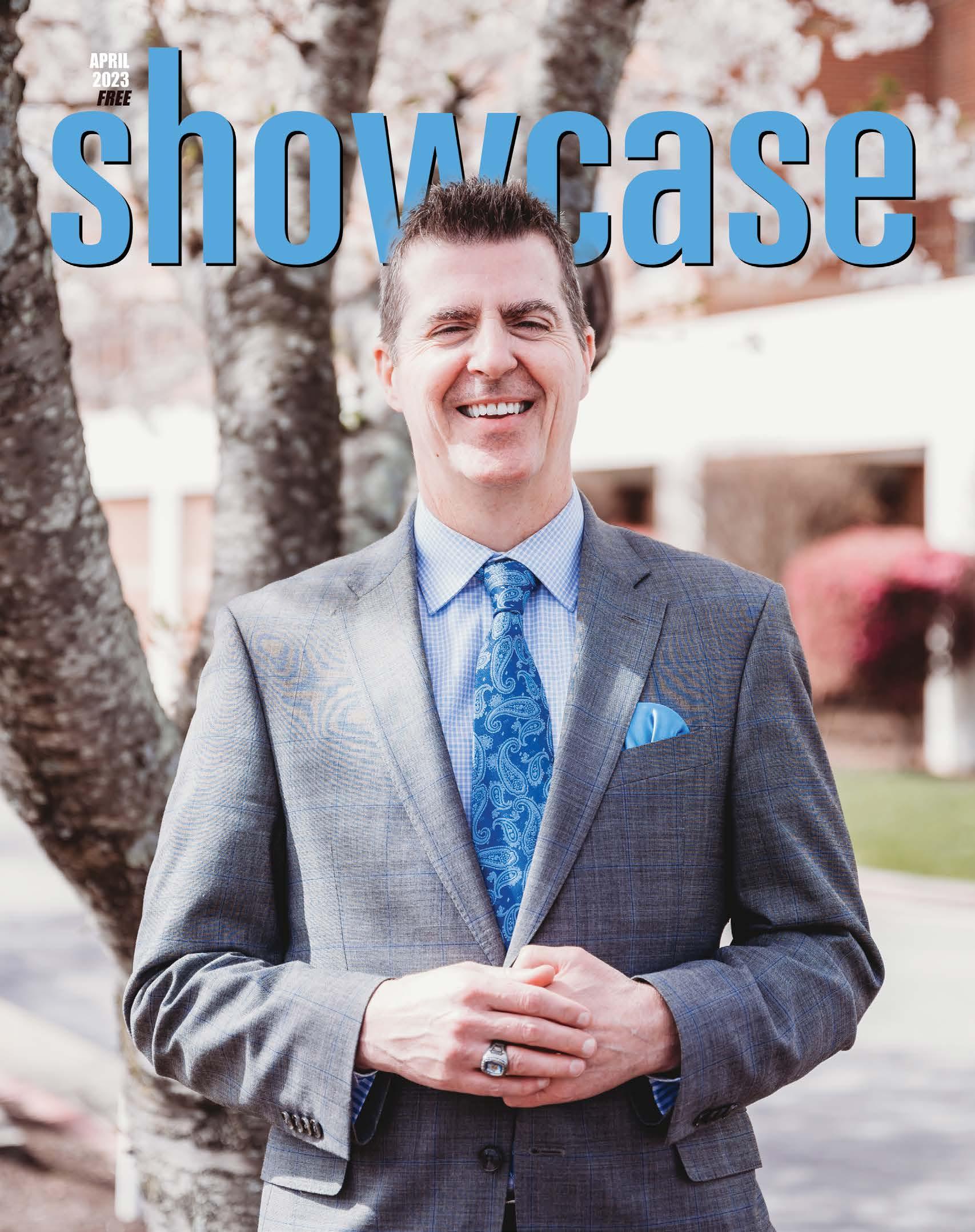












One Patient at a Time
One Patient at a Time
AN INTERVIEW WITH SOVAH
AN INTERVIEW WITH SOVAH
HEALTH CEO, STEVE HEATHERLY
HEALTH CEO, STEVE HEATHERLY












APRIL 2023
CEO Andrew Scott Brooks scott@showcasemagazine.com

EDITORIAL DIRECTOR
Paul Seiple | paul@showcasemagazine.com
GRAPHIC DESIGNER Kim Demont | demontdesign@verizon.net
FINANCE MANAGER Cindy Astin | cindy@showcasemagazine.com
ADVERTISING
Lee Vogler | Director of Sales and Marketing lee@showcasemagazine.com | 434.548.5335
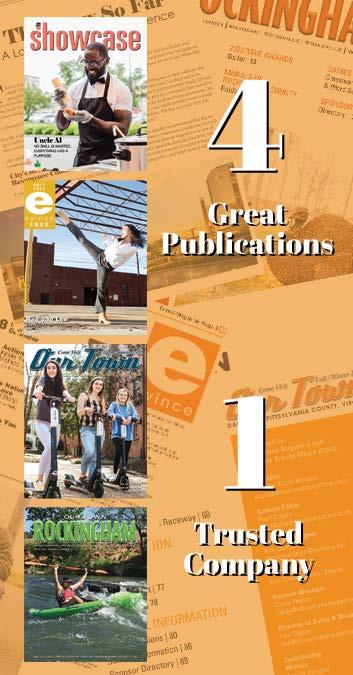
Emily Wilkerson | Executive Assistant emily@showcasemagazine.com
753 Main Street #3, Danville, VA 24541 Phone 434.709.7349 info@showcasemagazine.com www.showcasemagazine.com
CONTRIBUTING WRITERS
Paulette Dean | Barry Koplen
Victoria Scarce | Paul Seiple | Lee Vogler
CONTRIBUTING PHOTOGRAPHERS
Brianna Dawn | Barry Koplen | Jeremy Strange
Madelyn Lett Photography | Lee Vogler
COVER SOVAH Health CEO, Steve Heatherly photo by Madelyn Lett Photography Scan with your smart phone for EXCLUSIVE ONLINE CONTENT at showcasemagazine.com

New CEO of SOVAH Health, Steve Heatherly wants to see the hospital make a difference in individual lives and the community. He began a career in health care over 25 years ago after obtaining an undergraduate degree in financial management from UNC-Asheville. Heatherly then earned a master’s degree in business administration from Western Carolina University and a master’s degree in health care administration from UNC-Chapel Hill. He considers himself fortunate to have varied experience in health care, including being the CEO of multiple physician organizations and having been a CFO, COO, and CEO of hospital organizations.
Heatherly’s wife is an assistant principal at Tuscola High School in Waynesville, North Carolina. The couple has two sons. Their older son is preparing to go to medical school this summer. Their younger son is a sophomore at UNC-Charlotte. The Heatherlys are a sports family. They love going to sporting events together and are rabid fans of the Dallas Cowboys. Heatherly loves to exercise, read, and play golf occasionally, but confessed he is “not very good.”
Showcase sat down with the new CEO to discuss the current state of SOVAH Health, along with plans and improvements.
Showcase Magazine: What led you to take this position with SOVAH Health?
Steve Heatherly: I have a passion for rural health care. In rural communities, hospitals are, or should be, central to community life. I knew of SOVAH Health from my time as CEO of two Duke Lifepoint Hospitals in western North Carolina. When I was approached about this position, I was immediately interested due to the size of the market and opportunities I saw to make an impact on the communities served by SOVAH Health. In addition, I was drawn to how this community is poised to grow and wanted to be a part of that.
SM: What are some challenges you believe the hospitals in Danville and Martinsville currently face? And what are some challenges you foresee moving forward?
SH: Our campuses face workforce challenges that currently plague the entire hospital industry. In addition, we have some gaps in key physician specialties that must be filled. These things, taken together, sometimes mean that there are limits on the extent to which we can serve patients locally for the care we should provide. Though the issue has many facets that can vary daily, the staffing challenges have created a challenging operating environment in our emergency department where wait times can be too long, and we have to transfer too many patients. Our team is working diligently to improve that situation so that we can serve more patients in their community. While this is a challenge, we do have the staff to safely take care of our patients. Going forward, I think the staffing challenges will be with us for a while as they will be at almost every hospital. There simply are not enough clinical staff to go around, in most cases. The pandemic has fundamentally changed the workforce. We are going to have to rethink the way we engage people coming into the workforce, and how we assemble our care teams to include how we use technology to support our clinical staff in providing care.
SM: How do you plan to address some of the perception problems that SOVAH currently has?
SH: I have conducted interviews with over 100 people so far, both inside and outside our organization, and have come to understand that there are, indeed, perception challenges for our hospital campuses. The way I know to build trust and confidence is to do so one patient at a time. This will be a steady drumbeat in our facilities –meeting the needs of every single patient, one patient at a time. There are incredible people working at SOVAH Health. Talented people who want to care for their friends, families, and neighbors. I round on patients almost every day and there is certainly a disconnect between the overall perception and the generally positive feedback I get when I engage directly with patients and families. In some cases, we need to build capacity so that we can more reliably care for patients close to home. Finally, we need to be an engaged, authentic, and transparent partner with our key
Continued to Page 10
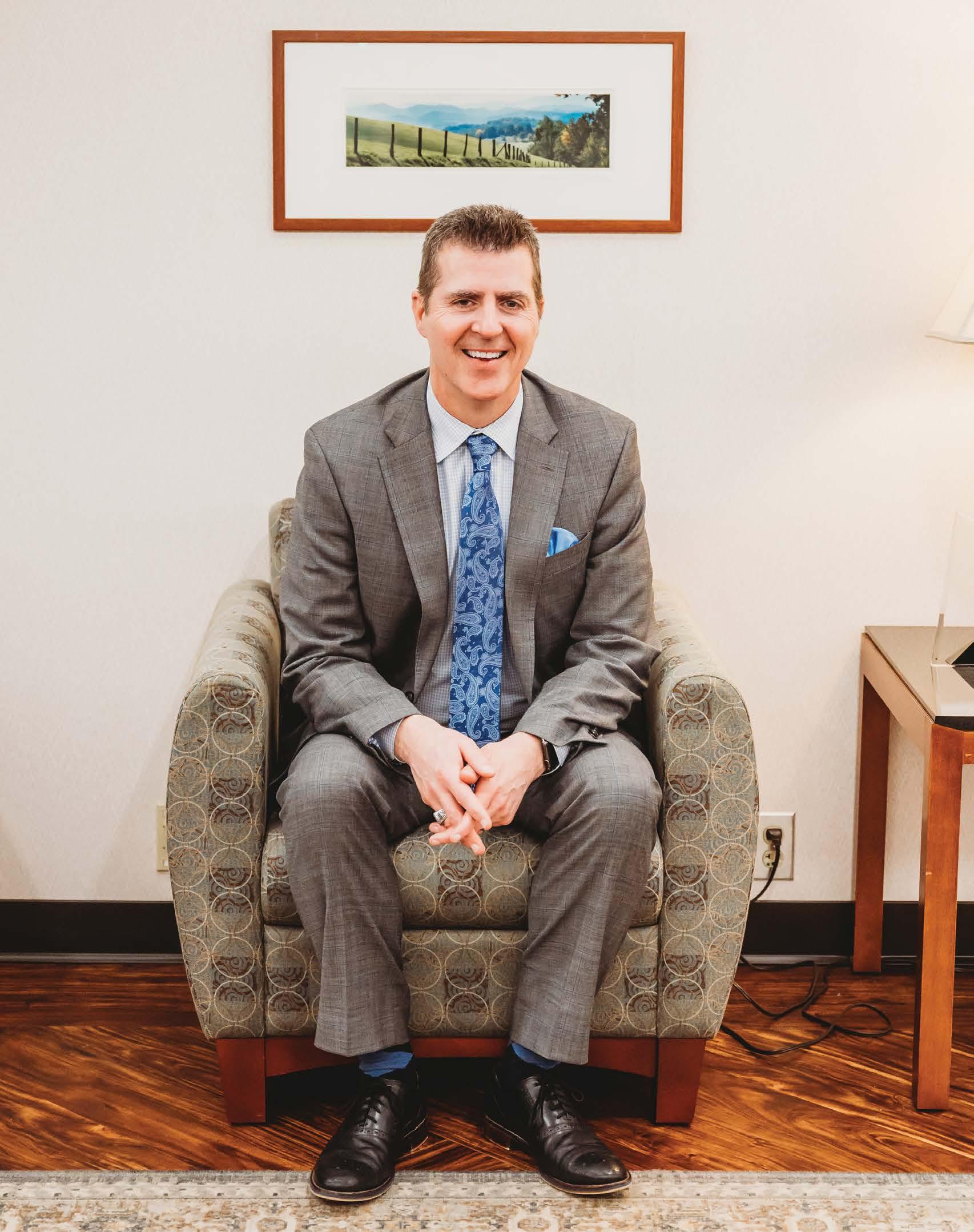
“I have a passion for rural health care. In rural communities, hospitals are, or should be, central to community life.”
- SOVAH Health CEO, Steve Heatherly
Continued from Page 8
community stakeholders, acknowledging our challenges and working collaboratively in a solution-oriented manner.
SM: How do you see technology playing a role in the future of health care and patient care at SOVAH Health?
SH: Clinical technology will continue to evolve and allow us to care for patients more efficiently and precisely. For example, we will install a new linear accelerator in our cancer center this year that will deliver more precise doses of radiation to cancer patients, allowing for more effective treatment with fewer side effects. Telehealth will continue to evolve and, I think, will make certain types of care more accessible. A good example is behavioral health in primary care. Our industry has a great opportunity to more effectively treat behavioral health conditions as a part of primary care, but there is a shortage of behavioral health practitioners. Telehealth can help minimize the shortage by making well-trained practitioners more widely accessible. I also think that the time has come for us to consider how virtual nursing can play a role in delivering care to inpatients, not as a replacement of bedside nurses, but as an aide to the work being done by bedside nurses, easing their burden during this intense labor shortage.
At SOVAH Health, we will be assessing technology, like robotic surgery, that will enable us to shorten lengths of stay and reduce complications for patients.
SM: What steps is SOVAH Health taking to promote diversity, equity, and inclusion within the organization and the wider community?
SH: One of our core values is Embracing Individuality. This is at the core of diversity, equity, and inclusion. One of my personal goals is to leverage the unique perspectives, talents, and experiences of each individual in our organization. Those items in each of us come from our unique journey, and taken together, make us stronger, individually and collectively. That is at the heart of diversity, equity, and inclusion.
The same principles apply in the wider community. One of the things I love about rural communities is that it truly takes all of us – individuals and organizations – doing our part for the community as a whole to realize its full potential. Implicit in that statement is valuing diversity so that we take advantage of the best in each of us, making for richer and better community life for all.
SM: Could you speak to any recent developments or initiatives within research or innovation at SOVAH Health?
SH: SOVAH Health engages in research and innovation in a variety of ways. First, our organization maintains a number of accreditations and certifications (e.g. Stroke Center, Chest Pain Center, Congestive Heart Failure) that require us to remain current on evolving evidence-based best practice so that the patients we serve are benefitting from the latest advancements in care delivery. In addition, our oncology program participates in and navigates patients through clinical trials for cancer treatment.
Our family medicine and internal medicine residency program has established a national best practice patient safety meeting in which residents, leaders, attending physicians, front-line staff, and others come together to study emerging patient safety issues, often solving them in real time. In addition, our residents are required to participate in research and scholarly activity. This academic year 23 projects were submitted with one winning a national first-place prize and another a national third-place prize.
SM: How does SOVAH Health collaborate with other healthcare providers and stakeholders in the region to improve health outcomes for the community?
SH: At SOVAH Health, we recognize that while we are central to meeting the health care needs of our communities, we cannot do it alone and must collaborate with many other agencies and organizations in the community. One way is to understand the health care needs and perspectives of key businesses in the community. To that end, we will be convening a Business Roundtable group to create a forum for dialogue. The first meeting of this group should be in the next 60 to 90 days. Creating a new generation of the health care workforce is essential to our future success and we partner with the school system, Danville Community College, and Averett University in a number of ways to meet this need. Working with various stakeholders to have a continuum of care for behavioral health is an important collaboration. Even within our physician community, we recognize that we can’t own every access point to care, so we endeavor to maintain an open dialogue with private practices and other providers so that we are coordinating efforts as best we can. Finally, I would say that successful collaboration with our emergency medical services providers is essential to the community having access to the right care at the right time. I am still learning about the challenges and opportunities, but can say that I will commit the organization to be a fully engaged partner.
This interview has been slightly edited for clarity.

“The way I know to build trust and confidence is to do so one patient at a time.”
- SOVAH Health CEO, Steve Heatherly
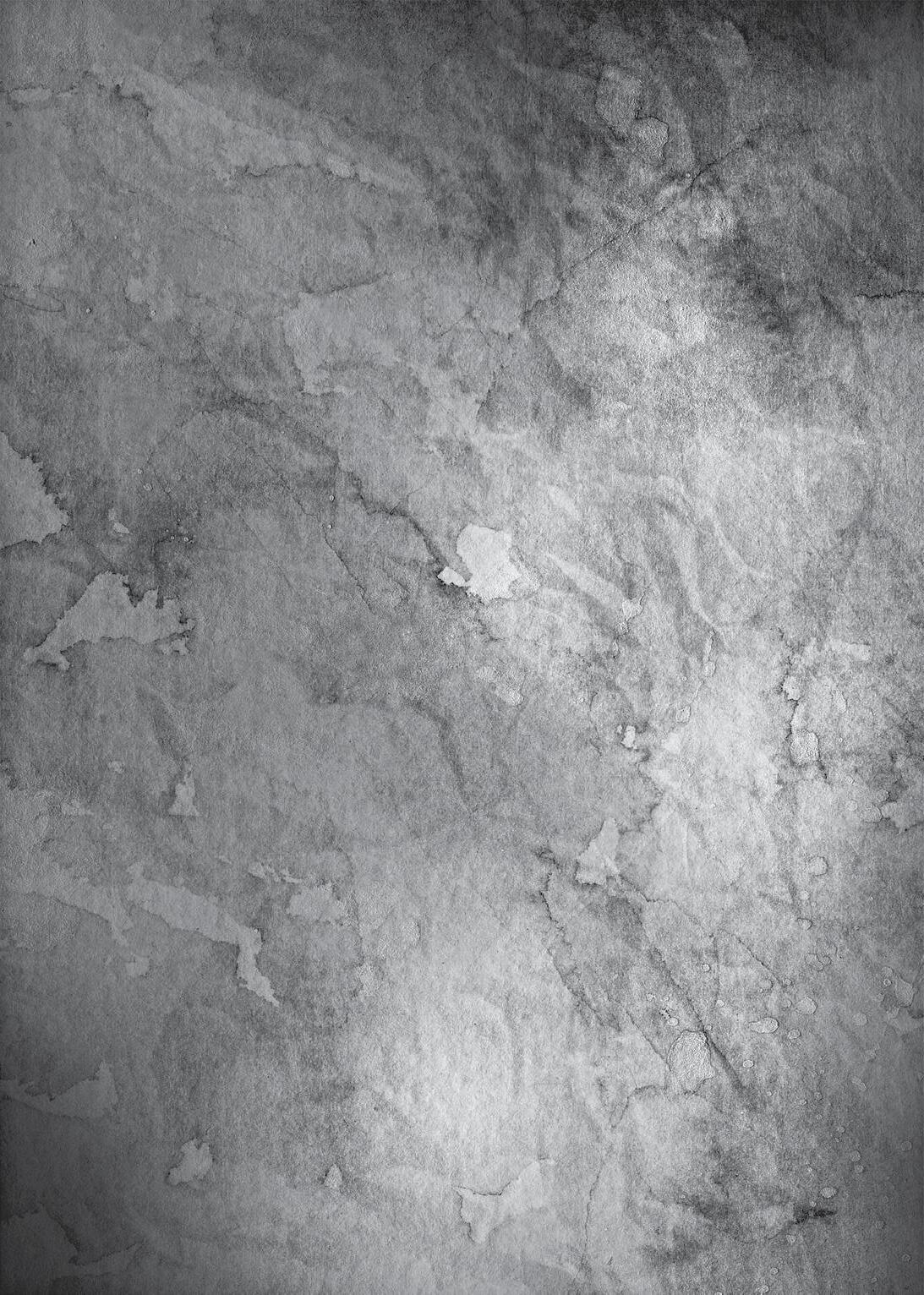



Iunintentionally started a feud about six months ago. I stopped by a local restaurant after the gym to pick up dinner. One employee was having a bad night, or so I thought. I’ve since learned that this employee seems to have a terrible night every time I’m in the restaurant. It is that, or he just doesn’t like me.
Our first interaction wasn’t good. It’s partly my fault. I guess I wasn’t having the greatest night, either. Anyway, I laughed when he flung food into my to-go box. I’m not exaggerating. He flung food into the container. It caught me off guard. My laughter stoked the fire. For the next move of aggression, he forcibly slid my food across the counter like a bartender shooting a beer down the bar. This action led to a co-worker shouting, “Jason.” (That’s not his name.) His behavior didn’t go unnoticed.
I laughed again and made a sarcastic comment about the service and left. The next day, I took the survey on the receipt and went into detail about how bad the experience was for me. I boycotted this restaurant. The district manager sent me an email apologizing for the experience and assured me the information would be shared with the manager.
I need to point out I think the first step is to discuss situations like this with the manager, but in this case, the manager was there and witnessed the whole thing. I wasn’t confident about the resolution, but I rethought the boycott and gave it another chance.
About a month or two later, I went back and faced my nemesis. I was determined the outcome would be different, even if he remained the same. I failed. There was laugher again after he slid the food to me like a Monica Abbott pitch. I’m positive I wasn’t the only person to receive this type of service. And clearly, the restaurant didn’t care about the “customer experience.”
I gave the boycott another thought, but I’m addicted to this place. So I went back a few weeks later and guess what? This guy still didn’t like me. But I went in with a different mindset. He eyed me and took nearly a minute to put on his gloves. There was tension, as if it was the
moment before the opening bell of Rocky versus Ivan Drago. But this time, I would not spar. I smiled and politely waited for him to finish. The order went the same as the others. I knew it would. I didn’t react, and I made sure he saw I left an over 100 percent tip. The interaction still left a foul taste in my mouth, but I felt better about my part in it.
I haven’t been back to see if things are different. Honestly, I may never go back, but this experience taught me a valuable lesson in control. Roman emperor and stoic, Marcus Aurelius said, “Be tolerant with others and strict with yourself.” Digging deeper into stoicism, a basic principle is you can’t control the way others act. You can only control how you react to the situation. I made the mistake of laughing during the first visit. It set off a chain reaction, and I continued to react poorly. I let the situation bother me. My defensive mechanisms kicked in, making it much worse.
My example does not differ from a driver who cuts you off in traffic or any other situation that causes a negative reaction. The key to keeping stress levels low and not making matters worse is to know the only thing in your control is the way you react to something. As much as I would love to have the superpower to delve into Jason’s mind and change his attitude, I can’t. I can chose to ignore his behavior and continue to go the restaurant. (This would be really hard for me though.) Or I can chose to not go to the restaurant. Again, it’s not the ideal situation, but it’s something I can control, and there are other restaurants.
Life becomes easier when you accept the truth of the only thing you can control is how you react to something. You cannot control the driver who cuts you off, but your day will be so much better if you just let it go. Like Marcus Aurelius said, “It’s time you realized that you have something inside you more powerful and miraculous than the things that affect you and make you dance like a puppet.”
Or, in my case, laugh just before takeout is hurled at me like a speeding comet.
Although I was curious regarding such a greeting, I simply nodded yes.
“I’ve been meaning to contact you. I’m Brian Dunevant.” Brian, the Assistant Director of Public Works for the City had a message for me. “It’s about the cobblestones,” he added, and he went on to mention the ones under North Union Street, paved over now. I’d called our City Manager to suggest that they be re-used as crosswalks when they repaved our street.
“We’re going to use the cobblestones
to create raised crossing paths to slow down traffic,” he said. “We hope to have everything done by December.”
Thanking him for that good news, I asked whether Quality Construction was bidding on the job. Knowing how well Harry and his crew did their work, I was glad to hear him say that Quality would probably be one of the few companies to bid on the work.

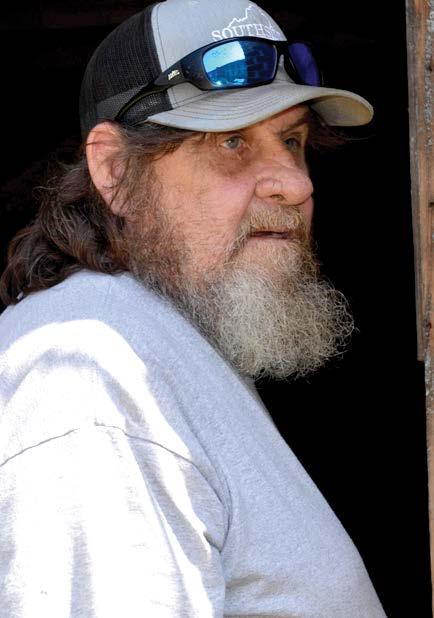
More of this story can be found in Barry Koplen’s book, DURHAM HOSIERY: REDUX et al.

My cousin Andy Koplen invited three of us to join him on his parent’s fishing boat at Smith Mountain Lake. That Lake had been manmade, part of a hydro-electric project not far from Roanoke, VA.
Much like our other fishing expeditions, we drove to the house that belonged to Andy’s folks. Their boat was tied to the dock by the cove at the bottom of their yard. For an hour and a half, until dark, four of us trolled the Lake then returned the boat to the dock.
While the other three feasted on snacks at the dining room table, I stood on the balcony that dark and clear October night to watch the sky and stars. Without turning around, I could reach the sliding glass door directly behind me; it opened to the dining room, three feet from its table.
Their chatter didn’t distract me as I studied the horizon because I noticed something I couldn’t explain. There was a dot of red light too high in the sky to be a Roanoke, VA street light forty miles away, but it was too low to be a star. For quite a while, I stared, looking for movement.
Finally, it moved. Only for a moment, the dot seemed to quiver.
But, in the next instant, quicker than I could snap my fingers, the craft appeared. It hadn’t made a sound; it stopped, sat still, about 75 feet in the air, about 150 feet from where I stood.
I was afraid, terrified by what I was seeing. At first, I froze. Then, knowing I had to tell the others, I opened the glass door. “You’ve gotta see this!” I yelled.
They hurried to the balcony, barely big enough for the four of us. For a few minutes, all of us stared at the saucer. I wasn’t the only one who wondered whether it was staring back at us.
Then, without a sound, it zipped up at a sharp angle, then zipped back in the opposite direction. Almost instantly, it was at full speed; it disappeared.
As the other three headed back inside, I asked my cousin whether his dad had any binoculars.
“Sure,” he said. Moments later, he handed me his dad’s Zeiss binoculars.
All three returned to the table; I returned to my post. If the craft came back, I would be ready. I tried not to be afraid; I convinced myself that the UFO might have had friendly intentions.
Shaped somewhat like an overturned cup on top of a saucer, the round saucer part seemed to have a diameter of about fifty feet. It appeared to be 20-25 feet tall.
Amazing to me, about five minutes later, it returned to the same spot and in the same way, without a sound! Raising the binoculars, I focused entirely on one of the rectangular windows, then ringed the top of the saucer. The windows were alternating red then white in color.
The craft was so close I was able to see that the light radiating from each window was opaque, so intense and dense that I could not see into the craft. Once again, I opened the door behind me.
“Hurry, guys!” I shouted. I wasn’t afraid as I’d been the first time.
We passed around the binoculars. Like me, they were fascinated. For the rest of the time, we were there and during our ride home; we didn’t talk much. It seemed that none of us knew what to say.
Other than my cousin, the other two men never contacted me to talk about the sighting. Occasionally, I returned to the cottage, hoping the saucer would return. It never did.
Although I tried to tell others about the saucer, most scoffed. Only my cousin and I talked about it. But the other two didn’t. That’s what I thought, but I couldn’t be sure because one of them was Gerald, a young man I didn’t know who was my cousin’s friend. For years after our sighting, he and I never saw each other.
Continued to Page 16
Continued from Page 15
Ten years later, after our very close encounter, I married and, eventually, told my wife. But she didn’t believe me, although I begged her to; she thought I was crazy.
That ended one night about five years later when she insisted that we go to a party. Because I didn’t think I’d know anyone there, I reluctantly agreed to join her at a huge backyard barbecue.
As soon as we entered the backyard, I spotted Gerald. He didn’t notice me; I hadn’t seen him since the night of our sighting.
Immediately, I pointed him out to my wife, told her he had seen the UFO with me. “If you don’t believe me,” I said, “ask him.” She was willing, so I hid in a spot where Gerald couldn’t see me.
She was gone for more than twenty minutes.
When she returned to my hiding place, she was uncommonly quiet until I asked whether Gerald had told her the same story I’d been telling her.
She looked up at me and said only one word. That word was “Verbatim,” as in word-for-word.
Years later, a young woman came in to my store. I recalled that my cousin had mentioned she was Gerald’s wife. But I wanted to be sure.
“Aren’t you married to Gerald?” I asked.
She looked at me, surprised by my question. “We were married,” she answered. “But we divorced a few years ago.”
Because that didn’t seem to upset her, I asked whether he ever talked to her about the UFO.
She laughed, then said, “That’s all he ever talked about!”
Years after that, while I was teaching at our community college, I decided to find Gerald to ask him whether he would tell my class about what we saw that night at the lake. Since he had told his former wife and mine, I assumed he wouldn’t mind doing that.
It took me almost a week to locate his phone number.
When I called him to ask whether he would speak to my class, he stopped talking. I waited for him to answer. But he didn’t. Finally, I interrupted the silence and asked him to just think about it. He responded in a shaky voice. He sounded scared.
“I will,” he said, sounding barely audible.
That was years ago. I’m still waiting for him to call.
However, I spoke to Stanton Friedman days after our sighting, one of America’s top UFO researchers. For many years, he has been one of the featured speakers at the annual UFO Conference in Roswell.
After we’d talked for forty minutes, he told me that, of all the credible UFO stories he had heard, my story ranked in the top ½ of 1%! In time, I realized why.
A few may have seen such a craft as close as we did, but no one had seen it coming from outer space!
Despite having had that unique experience, I didn’t feel compelled to write a book about it until two things happened. Unusual as they were, those two things took a while.
The first had to do with my brother. Because my brother and I were very close, his opinion mattered to me, especially because I’d grown weary of friends doubting me. At times, I felt an urge to give up trying to share my story.
That’s why I spoke to my brother who lived in Colorado; I knew he would be understanding and supportive.
However, when I told him, I was both surprised and saddened when he said, “That’s a great story, but I don’t think you saw a flying saucer.”
I wanted to scream a question at him. “Why would I make up such a story?” But, in a quieter, more controlled voice, that’s what I asked him. I felt that the one person on the planet who I could rely on to share my difficult truth would be him. After all, I knew what it felt like to be afraid to tell my story. At first, it was difficult; people might think I was crazy.
And what might happen if the dean of my college was upset because I used my story in my classroom? I didn’t know whether I might be fired because of that.
But I thought my brother would understand how difficult it was and how important it was for him to be my confidante.
That’s why I waited to write the book until AFTER I had taken a lie detector test, a real lie detector test. To do that, I hired the best person I could find. He was the same man who the state of North Carolina trusted to test people accused of murder to determine whether they were telling
the truth about what they did or didn’t do.
Although I’d heard I could fool one of those tests, I quickly realized that was a myth. When he strapped me into a chair and hooked up a series of electrodes to various parts of my body, I couldn’t move. Being seated like that was grueling and painful. I couldn’t even squirm and could only answer questions he asked. Otherwise, I couldn’t talk. Sitting in his hardback chair was so uncomfortable that I wanted to stop when we were half through.
But I couldn’t. Not only had I paid dearly for the test, but I also wanted to include the results in the book I would write; I gritted my teeth and endured.
But I will never do a lie detector test again.
As for the results, they are in my book titled Why Won’t They Believe Me? Four of us saw the saucer! Twice! [The updated version is titled Close Encounter at Smith Mountain Lake, VA]
But there was one other thing that had to happen before I wrote my book. That ‘other thing’ was this: I had to visit
the UFO Museum in Roswell. I wanted to go there and tell them my story. If they liked it, I figured they might want me to present my story to their annual conference.
I went. And I told them my story. Then they asked me one question.
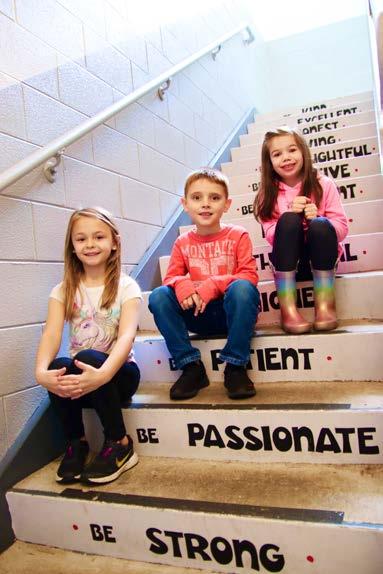
“Have you written a book about it?”

Although that was certain to be a lengthy process, I told them I would. When I returned home, I wrote the book, had it published, and contacted them.



“We need to read it first,” they told me, “and then we’ll let you know.”
The next day, I sent a copy to them.
Almost six months later, I received a notice from them. I knew I couldn’t guess what it said.
That’s why I read their note very slowly and very carefully.
They wanted to buy twelve copies of my book for their gift shop! My story had made it to the UFO Museum!

 BY LEE VOGLER
BY LEE VOGLER
 PHOTO BY LEE VOGLER
PHOTO BY LEE VOGLER


recently that we should work out together more often. Zumba wasn’t exactly what I had in mind, but since she asked, I thought I’d be a good sport and give it a shot.
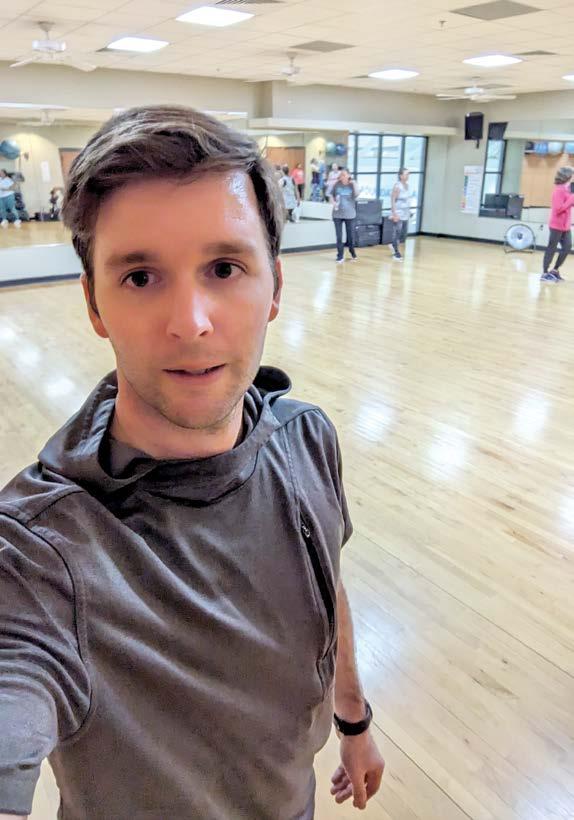
Spring is here and with it comes a time for renewal. For me, a big part of renewal is trying new things. Those who follow this column know I’ve been on a health journey for the last year or so. (Update: I’ve lost around 34 pounds since the start of 2022.) I stay in pretty good shape. Outside of the couple months I was recovering from a fractured fibula, I jog regularly. I lift weights. I eat healthy. All of those things.
But recently I tried something I had

It was fun! I won’t lie to you and tell you I was a natural at it, or even that it’s something I’ll be doing regularly, but it was something outside of my comfort zone, and therefore, a bit of a challenge for me. That’s something I enjoy and thus, I liked the class.

I often think of the book Green Eggs and Ham and pass along the message from that story to my kids. But within that children’s book is an important message for all of us, no matter our age: don’t be afraid to try Saturday, April

“What would life be if we had no courage to attempt anything?”
– Vincent Van Gogh
Arelatively new act, MaMa BriBri and The Stranger are excited to showcase their music and connect with their growing audience. A mother of three and musician, Briana, or MaMa BriBri, spends her days in the Halifax area; Jeremy Strange (The Stranger), guitarist, moved around from Colorado, North Carolina, and Nashville, before settling back in his hometown of Danville.
Both Briana and Jeremy grew up with supportive parents who influenced their tastes in music. Briana, rock singer and rhythm guitarist, draws inspiration from her parents and the music they introduced her to, “So many of the songs I cover in our band are songs my mom used to play when I was a kid...my dad is responsible for the quirkier side of my tastes.” Jeremy Strange, an audio engineer and guitarist, was introduced to music through his parents listening to country music on local radio station WAKG and expanded his interests through video games and movies.
Both artists cite a wide variety of genres as their favorites, ranging from Fleetwood Mac and ABBA to Ennio
Morricone and John Carpenter, to Jimi Hendrix, Nine Inch Nails, and Tony Iommi (Black Sabbath guitarist). They both share a love for grunge-era rock, which helps them connect musically.
As far as instruments that they play, both Briana and Jeremy have a repertoire of at least three instruments. Briana answered that her voice is her main instrument, but “I play guitar and dabble with other instruments like ukulele and bass.” Jeremy stated he has been playing the guitar since he was fourteen and he also plays “bass, and a little keys.”
Both artists mentioned a true love and passion for music, even going as far to say that the act of performing, practicing, and even just listening to music is “medicinal and therapeutic.” While the creative process looks different for every musician, Jeremy and Briana both agree that their work is important and the reward greatly outweighs the necessary work and practice.
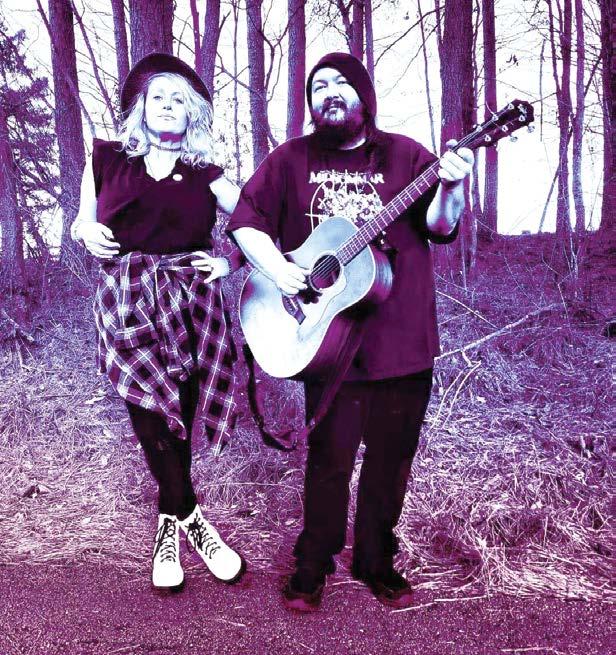
When asked about the most important skills for a musician to have, Briana emphasized the importance of connecting with the audience and reading the room, saying, “being able to share energy with the crowd is really important... that’s the whole goal, to connect.” Jeremy highlighted the importance of staying calm under pressure, working as a team, and having confidence without an ego. He also noted that understanding marketing and business can go a long way in the music industry.
As for their goals for the next year, Briana and Jeremy both aspire to play as many gigs in as many venues as possible. Briana said, “We are a relatively new act, so just getting our name out there and playing more is the main goal.” Jeremy added, “Our goal is just to keep on creating and sharing our music with as many people as we can.”
Overall, Briana Dawn and Jeremy Strange share a deep love and passion for music and a commitment to continuously improving and growing as musicians. Briana’s advice to aspiring musicians is to “never give up and dedicate yourself to always becoming a better musician,” while Jeremy urges others to “practice, learn what you love, and don’t give up. Also, never be afraid to try new things.”
We are thrilled that a growing number of people are choosing to have their dogs and cats micro-chipped.
Sometimes when we receive an animal at the shelter, we just know that he or she must have merely wandered away from a loving home. However, there is no way to identify an owner through a tag on a collar or through a microchip. All we can do is hold the animal the required stray time and hope that an owner comes forward.
Although both the City of Danville and Pittsylvania County require tags, sometimes they can be lost. There is a simple thing that owners can do to improve the chance that a lost dog or cat will be reunited with their owner. Micro-chipping has been popular for many years, and we are seeing an increase in the number of animals received with microchips.


The chip is about the size of a grain of uncooked rice; it is implanted under the loose skin between the shoulder blades. The process is quick and no more painful than a vaccination. (Well, at least that is what the microchip companies tell us. I have seen tiny Yorkies stand unflinching while they are being micro-chipped; however, I have also seen huge Golden Retrievers or Rottweilers being very dramatic.
Although my shelter-adopted cat is a strictly inside cat, he is micro-chipped. Because of that, he has another layer of protection in being returned to me if he somehow escapes from my house.
A simple procedure with a scanner alerts a shelter that a microchip has been inserted. The owner’s name and address can be registered on a national database.
If your dogs and cats have not been micro-chipped, please call your veterinary clinic and schedule to have one implanted. Also, watch for our low-cost microchip clinics at the shelter! It is a very quick procedure, and you will have added another layer of protection for your lost pet.


